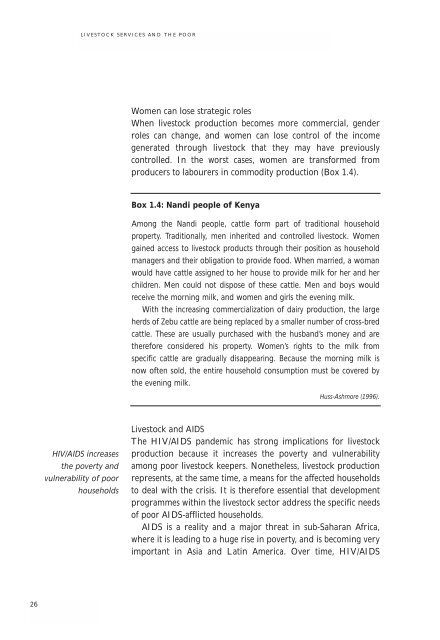Livestock Services and the Poor: A global initiative - IFAD
Livestock Services and the Poor: A global initiative - IFAD
Livestock Services and the Poor: A global initiative - IFAD
Create successful ePaper yourself
Turn your PDF publications into a flip-book with our unique Google optimized e-Paper software.
26<br />
LIVESTOCK SERVICES AND THE POOR<br />
HIV/AIDS increases<br />
<strong>the</strong> poverty <strong>and</strong><br />
vulnerability of poor<br />
households<br />
Women can lose strategic roles<br />
When livestock production becomes more commercial, gender<br />
roles can change, <strong>and</strong> women can lose control of <strong>the</strong> income<br />
generated through livestock that <strong>the</strong>y may have previously<br />
controlled. In <strong>the</strong> worst cases, women are transformed from<br />
producers to labourers in commodity production (Box 1.4).<br />
Box 1.4: N<strong>and</strong>i people of Kenya<br />
Among <strong>the</strong> N<strong>and</strong>i people, cattle form part of traditional household<br />
property. Traditionally, men inherited <strong>and</strong> controlled livestock. Women<br />
gained access to livestock products through <strong>the</strong>ir position as household<br />
managers <strong>and</strong> <strong>the</strong>ir obligation to provide food. When married, a woman<br />
would have cattle assigned to her house to provide milk for her <strong>and</strong> her<br />
children. Men could not dispose of <strong>the</strong>se cattle. Men <strong>and</strong> boys would<br />
receive <strong>the</strong> morning milk, <strong>and</strong> women <strong>and</strong> girls <strong>the</strong> evening milk.<br />
With <strong>the</strong> increasing commercialization of dairy production, <strong>the</strong> large<br />
herds of Zebu cattle are being replaced by a smaller number of cross-bred<br />
cattle. These are usually purchased with <strong>the</strong> husb<strong>and</strong>’s money <strong>and</strong> are<br />
<strong>the</strong>refore considered his property. Women’s rights to <strong>the</strong> milk from<br />
specific cattle are gradually disappearing. Because <strong>the</strong> morning milk is<br />
now often sold, <strong>the</strong> entire household consumption must be covered by<br />
<strong>the</strong> evening milk.<br />
Huss-Ashmore (1996).<br />
<strong>Livestock</strong> <strong>and</strong> AIDS<br />
The HIV/AIDS p<strong>and</strong>emic has strong implications for livestock<br />
production because it increases <strong>the</strong> poverty <strong>and</strong> vulnerability<br />
among poor livestock keepers. None<strong>the</strong>less, livestock production<br />
represents, at <strong>the</strong> same time, a means for <strong>the</strong> affected households<br />
to deal with <strong>the</strong> crisis. It is <strong>the</strong>refore essential that development<br />
programmes within <strong>the</strong> livestock sector address <strong>the</strong> specific needs<br />
of poor AIDS-afflicted households.<br />
AIDS is a reality <strong>and</strong> a major threat in sub-Saharan Africa,<br />
where it is leading to a huge rise in poverty, <strong>and</strong> is becoming very<br />
important in Asia <strong>and</strong> Latin America. Over time, HIV/AIDS

















